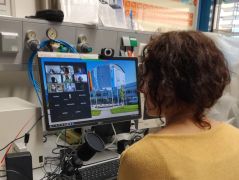MLZ is a cooperation between:
 > Technische Universität München
> Technische Universität München > Helmholtz-Zentrum Hereon
> Helmholtz-Zentrum Hereon
 > Forschungszentrum Jülich
> Forschungszentrum Jülich
MLZ is a member of:
 > LENS
> LENS > ERF-AISBL
> ERF-AISBL
MLZ on social media:

MLZ (eng)
Lichtenbergstr.1
85748 Garching
10.10.2024
Girls’ Day: Following in the Footsteps of Lise Meitner and Marie Curie
Once again this year, the FRM II opened its doors for Girls’ Day. On April 25, 23 girls had the chance to gain insight into the world of neutrons and the daily life of a scientist or laboratory technician.

On the way to the neutron guide hall, a short stop is made in front of the old reactor for a group photo. © FRM II / TUM
“Do you know a famous female physicist?” asked the two presenters Veronika Reich (Helmholtz-Zentrum Hereon) and Dr. Johanna K. Jochum (TUM), both scientists at the Heinz Maier-Leibnitz Center (MLZ). This was not an easy question for the visitors on Girls’ Day 2024. Some were guided in the right direction by Johanna Jochum’s Lise Meitner shirt, and most had heard of Marie Curie before. But during the presentations, the seventh- to tenth-grade girls also learned about other important female scientists, along with exciting information about neutrons and FRM II.
Questions, facts and fascinating discoveries
After some initial hesitation, the visitors began challenging the scientists. They asked questions such as: “What happened at Chernobyl?”, “Is it dangerous to touch an alarm clock with radium numbers?” and “Who works here, anyway?”
The students learned a lot of new things: “Chernobyl was a series of unfortunate coincidences, design and operational errors, and inadequate safety measures. The overheating of the fuel elements ultimately caused the reactor core to explode, releasing large amounts of radioactivity.” The scientists also explained that such an event couldn’t happen in Garching due to the completely different technology used there.
“From archaeological finds like dinosaur eggs, to needles for medical use, and snail teeth, we’ve examined everything,” reported Dr. Tobias Neuwirth (TUM), which certainly astonished them.

Visualization of how the ANTARES instrument works using an example of how coffee is made in an espresso maker. © Tobias Neuwirth
Focusing on neutron radiation: From model to impressive Reality
Tobias Neuwirth, a postdoc at FRM II, not only had detailed facts and figures but also brought his own instrument. With his self-built ANTARES model, a scientific instrument for radiography and tomography, he demonstrated the neutron radiography of an object. In the model, this was simulated by lighting up a bulb. He impressively illustrated how his instrument works and showed a fascinating video from the real ANTARES, where coffee was being brewed in an espresso maker.
After a walk around the facility and a brief security check, they visited the neutron guide hall. The students were captivated by the neutron guides, which were far more impressive in real life than in pictures.
Into practice with lab coats and safety goggles
How high is the radiation from banana chips, how do you separate two phases from each other and how do you protect yourself from contamination with rubber gloves? In the lab, the girls donned lab coats and safety goggles and got hands-on with exciting discoveries.
“0.1 µSv – is that a lot or a little radiation?” asked Tabea Bartelt from the Forschungszentrum Jülich, who supervised the girls in the lab, testing the knowledge they had gained from the presentations. “Obviously little – that’s the radiation dose of a banana, basically ‘everyday radiation’,” the students correctly answered.

In the laboratory, the girls were able to measure the radiation of various objects, such as banana chips or sandstone, using a Geiger counter. © FRM II / TUM
On to the parabolic slide: The journey of siscovery is not over yet
The girls followed the various stations with great interest and felt that their time at FRM II went by far too quickly.
However, the budding scientists are not too disappointed, as the campus in Garching has much more to offer. Thanks to the presenters, they were already excited about the parabolic slide and the real periodic table in the chemistry building and could hardly wait to continue exploring the world of natural sciences.
With their minds filled with new knowledge, an increased thirst for learning, and goodie bags full of treats, the participants headed to the building of the TUM School of Computation, Information and Technology at the Technical University of Munich to try out the slides there.
At the end of the day, Johanna Jochum and Veronika Reich were pleased: “We’re confident that we’ll see some of them again soon – either in an internship or on a tour for visitors aged 16 and older.”
Related News
MLZ is a cooperation between:
 > Technische Universität München
> Technische Universität München > Helmholtz-Zentrum Hereon
> Helmholtz-Zentrum Hereon
 > Forschungszentrum Jülich
> Forschungszentrum Jülich
MLZ is a member of:
 > LENS
> LENS > ERF-AISBL
> ERF-AISBL
MLZ on social media:




